Vortex-Pressure Fluctuation Interaction in the Outlet Duct of Centrifugal Pump as Turbines (PATs)
Abstract
1. Introduction
2. Numerical Method
2.1. Physical Model
2.2. Governing Equations and Turbulence Model
2.3. Numerical Schemes and Boundary Conditions
2.4. Mesh Generation and Sensitivity Analysis
2.5. Validation of Numerical Results
3. Results and Discussion
3.1. Spatial and Temporal Evolution of the Vortex
3.2. Vorticity and Pressure Fluctuation Characteristics
4. Conclusions
- (1)
- The vortex behavior in the outlet duct of PATs was determined by the flow rate. Under the part load condition, the vortex with small-scale and the multiple vortex rope was slender at the central of outlet duct. The vortex rope was spiral, and its length varied with the impeller rotating at over load condition. At BEP condition, the location of the vortex was basically consistent with other operating conditions, but the vortex rope did not appear in the outlet duct.
- (2)
- The leakage flow and the blade-vortex or trailing edge vortex propagated from upstream significantly influenced the distribution of the vortex in the outlet duct. The different types of vortexes, such as source vortexes and sink vortexes, were located at the local low-velocity regions in the section planes of the outlet duct. With the section plane away from the inlet of the outlet duct, the number of vortexes in the section planes declined.
- (3)
- The vorticity fluctuation dominant frequency in the outlet duct was comprehensively affected by the rotor-stator interaction, the vortex propagated from the upstream, and the new vortex generated in it. However, the pressure fluctuation dominant frequency was blade pass frequency and did not change with the flow rate and position of monitoring points. As the flow rate increased, the amplitude of pressure fluctuation increased, while the effect of vortex evolution affecting the local pressure fluctuation weakened in the outlet duct. With the section plane away from the inlet of the outlet duct, the evolution effect of the vortex affected the local pressure fluctuation, which decreased.
Author Contributions
Funding
Institutional Review Board Statement
Informed Consent Statement
Data Availability Statement
Conflicts of Interest
References
- Xin, T.; Wei, J.; Qiuying, L.; Hou, G.; Ning, Z.; Yuchuan, W.; Diyi, C. Analysis of hydraulic loss of the centrifugal pump as turbine based on internal flow feature and entropy generation theory. Sustain. Energy Technol. Assess. 2022, 52, 102070. [Google Scholar] [CrossRef]
- Lin, T.; Zhu, Z.; Li, X.; Li, J.; Lin, Y. Theoretical, experimental, and numerical methods to predict the best efficiency point of centrifugal pump as turbine. Renew. Energy 2021, 168, 31–44. [Google Scholar] [CrossRef]
- Lin, T.; Li, X.; Zhu, Z.; Xie, J.; Li, Y.; Yang, H. Application of enstrophy dissipation to analyze energy loss in a centrifugal pump as turbine. Renew. Energy 2021, 163, 41–55. [Google Scholar] [CrossRef]
- Zhou, L.; Hang, J.; Bai, L.; Krzemianowski, Z.; El-Emam, M.A.; Yasser, E.; Agarwal, R. Application of entropy production theory for energy losses and other investigation in pumps and turbines: A review. Appl. Energy 2022, 318, 119211. [Google Scholar] [CrossRef]
- Binama, M.; Su, W.-T.; Li, X.-B.; Li, F.-C.; Wei, X.-Z.; An, S. Investigation on pump as turbine (PAT) technical aspects for micro hydropower schemes: A state-of-the-art review. Renew. Sustain. Energy Rev. 2017, 79, 148–179. [Google Scholar] [CrossRef]
- Liu, M.; Tan, L.; Cao, S. Theoretical model of energy performance prediction and BEP determination for centrifugal pump as turbine. Energy 2019, 172, 712–732. [Google Scholar] [CrossRef]
- Li, W. Vortex Pump as Turbine—A Type Turbine for Energy Generation or Recovery Based on Computational Fluid Dynamics Prediction. J. Fluids Eng. 2019, 141, 101105. [Google Scholar] [CrossRef]
- Abazariyan, S.; Rafee, R.; Derakhshan, S. Experimental study of viscosity effects on a pump as turbine performance. Renew. Energy 2018, 127, 539–547. [Google Scholar] [CrossRef]
- Plua, F.; Hidalgo, V.; López-Jiménez, P.; Pérez-Sánchez, M. Analysis of Applicability of CFD Numerical Studies Applied to Problem When Pump Working as Turbine. Water 2021, 13, 2134. [Google Scholar] [CrossRef]
- Lin, T.; Li, X.; Zhu, Z.; Xie, R.; Lin, Y. Investigation of flow separation characteristics in a pump as turbines impeller under the best efficiency point condition. J. Fluids Eng. 2021, 143, 061204. [Google Scholar] [CrossRef]
- Štefan, D.; Rossi, M.; Hudec, M.; Rudolf, P.; Nigro, A.; Renzi, M. Study of the internal flow field in a pump-as-turbine (PaT): Numerical investigation, overall performance prediction model and velocity vector analysis. Renew. Energy 2020, 156, 158–172. [Google Scholar] [CrossRef]
- Ghorani, M.M.; Haghighi, M.H.S.; Riasi, A. Entropy generation minimization of a pump running in reverse mode based on surrogate models and NSGA-II. Int. Commun. Heat Mass Transf. 2020, 118, 104898. [Google Scholar] [CrossRef]
- Ghorani, M.M.; Haghighi, M.H.S.; Maleki, A.; Riasi, A. A numerical study on mechanisms of energy dissipation in a pump as turbine (PAT) using entropy generation theory. Renew. Energy 2020, 162, 1036–1053. [Google Scholar] [CrossRef]
- Wang, T.; Wang, C.; Kong, F.; Gou, Q.; Yang, S. Theoretical, experimental, and numerical study of special impeller used in turbine mode of centrifugal pump as turbine. Energy 2017, 130, 473–485. [Google Scholar] [CrossRef]
- Wang, X.; Kuang, K.; Wu, Z.; Yang, J. Numerical simulation of axial vortex in a centrifugal pump as turbine with S-blade impeller. Processes 2020, 8, 1192. [Google Scholar] [CrossRef]
- Delgado, J.; Ferreira, J.P.; Covas, D.I.C.; Avellan, F. Variable speed operation of centrifugal pumps running as turbines. Experimental investigation. Renew. Energy 2019, 142, 437–450. [Google Scholar] [CrossRef]
- Shojaeefard, M.H.; Saremian, S. Effects of impeller geometry modification on performance of pump as turbine in the urban water distribution network. Energy 2022, 255, 124550. [Google Scholar] [CrossRef]
- Hongyu, G.; Wei, J.; Yuchuan, W.; Hui, T.; Ting, L.; Diyi, C. Numerical simulation and experimental investigation on the influence of the clocking effect on the hydraulic performance of the centrifugal pump as turbine. Renew. Energy 2021, 168, 21–30. [Google Scholar] [CrossRef]
- Dai, C.; Kong, F.; Dong, L.; Feng, Z.; Bai, Y. Analysis and experimental investigation of pressure fluctuation in draft tube of pump as turbine. J. Cent. South Univ. 2015, 46, 3131–3137. (In Chinese) [Google Scholar]
- Wu, X.; Liu, S.; Wu, Y. Detached eddy simulation for model hydro turbine. In Proceedings of the ASME fluids engineering Division Summer Meeting, Miami, FL, USA, 17–20 July 2006; pp. 211–218. [Google Scholar]
- Jain, S.V.; Patel, N.K.; Patel, R.N. Experimental investigations of cavitation characteristics of pump running in turbine mode. J. Energy Eng. 2017, 143, 04016034. [Google Scholar] [CrossRef]
- Dong, L.; Dai, C.; Lin, H.-B.; Chen, Y.-P. Noise comparison of centrifugal pump operating in pump and turbine mode. J. Cent. South Univ. 2018, 25, 2733–2753. [Google Scholar] [CrossRef]
- Fei, Z.; Zhang, R.; Xu, H.; Feng, J.; Mu, T.; Chen, Y. Energy performance and flow characteristics of a slanted axial-flow pump under cavitation conditions. Phys. Fluids 2022, 34, 035121. [Google Scholar] [CrossRef]
- Lin, Y.; Li, X.; Zhu, Z.; Wang, X.; Lin, T.; Cao, H. An energy consumption improvement method for centrifugal pump based on bionic optimization of blade trailing edge. Energy 2022, 246, 123323. [Google Scholar] [CrossRef]
- Wu, C.; Pu, K.; Li, C.; Wu, P.; Huang, B.; Wu, D. Blade redesign based on secondary flow suppression to improve energy efficiency of a centrifugal pump. Energy 2022, 246, 123394. [Google Scholar] [CrossRef]
- Ji, L.; Li, W.; Shi, W.; Chang, H.; Yang, Z. Energy characteristics of mixed-flow pump under different tip clearances based on entropy production analysis. Energy 2020, 199, 117447. [Google Scholar] [CrossRef]
- Zhang, F.; Appiah, D.; Hong, F.; Zhang, J.; Yuan, S.; Adu-Poku, K.A.; Wei, X. Energy loss evaluation in a side channel pump under different wrapping angles using entropy production method. Int. Commun. Heat Mass Transf. 2020, 113, 104526. [Google Scholar] [CrossRef]
- Spalart, P.R.; Shur, M. On the sensitization of turbulence models to rotation and curvature. Aerosp. Sci. Technol. 1997, 1, 297–302. [Google Scholar] [CrossRef]
- Roache, P.J. Quantification of uncertainty in computational fluid dynamics. Annu. Rev. Fluid Mech. 1997, 29, 123–160. [Google Scholar] [CrossRef]
- Celik, I.B.; Ghia, U.; Roache, P.; Freitas, C.J. Procedure for estimation and reporting of uncertainty due to discretization in CFD applications. J. Fluids Eng. Trans. ASME 2008, 130, 078001. [Google Scholar]
- Wang, L.; Wu, T.; Gong, J.; Yang, Y. Numerical simulation of the wake instabilities of a propeller. Phys. Fluids 2021, 33, 125125. [Google Scholar] [CrossRef]
- Manolesos, M.; Papadakis, G. Investigation of the three-dimensional flow past a flatback wind turbine airfoil at high angles of attack. Phys. Fluids 2021, 33, 085106. [Google Scholar] [CrossRef]
- Lu, J.; Chen, Q.; Liu, X.; Zhu, B.; Yuan, S. Investigation on pressure fluctuations induced by flow instabilities in a centrifugal pump. Ocean. Eng. 2022, 258, 111805. [Google Scholar] [CrossRef]
- Hunt, J.C.R.; Wray, A.A.; Moin, P. Eddies, streams, and convergence zones in turbulent flows. In Proceedings of the Studying Turbulence Using Numerical Simulation Databases, 2. Proceedings of the 1988 Summer Program, Stanford, CA, USA, 27 Jun–22 July 1988; pp. 193–208. [Google Scholar]
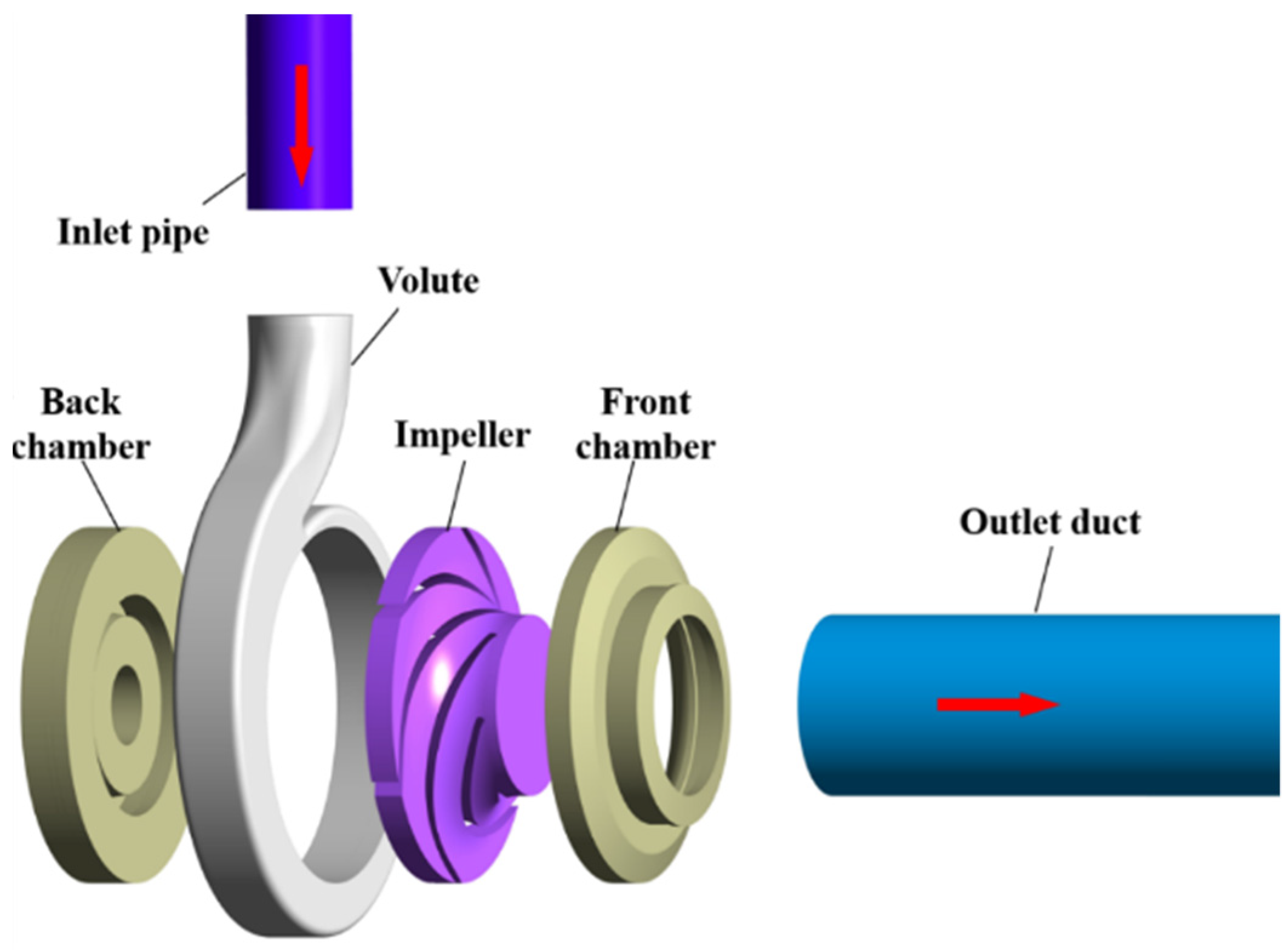
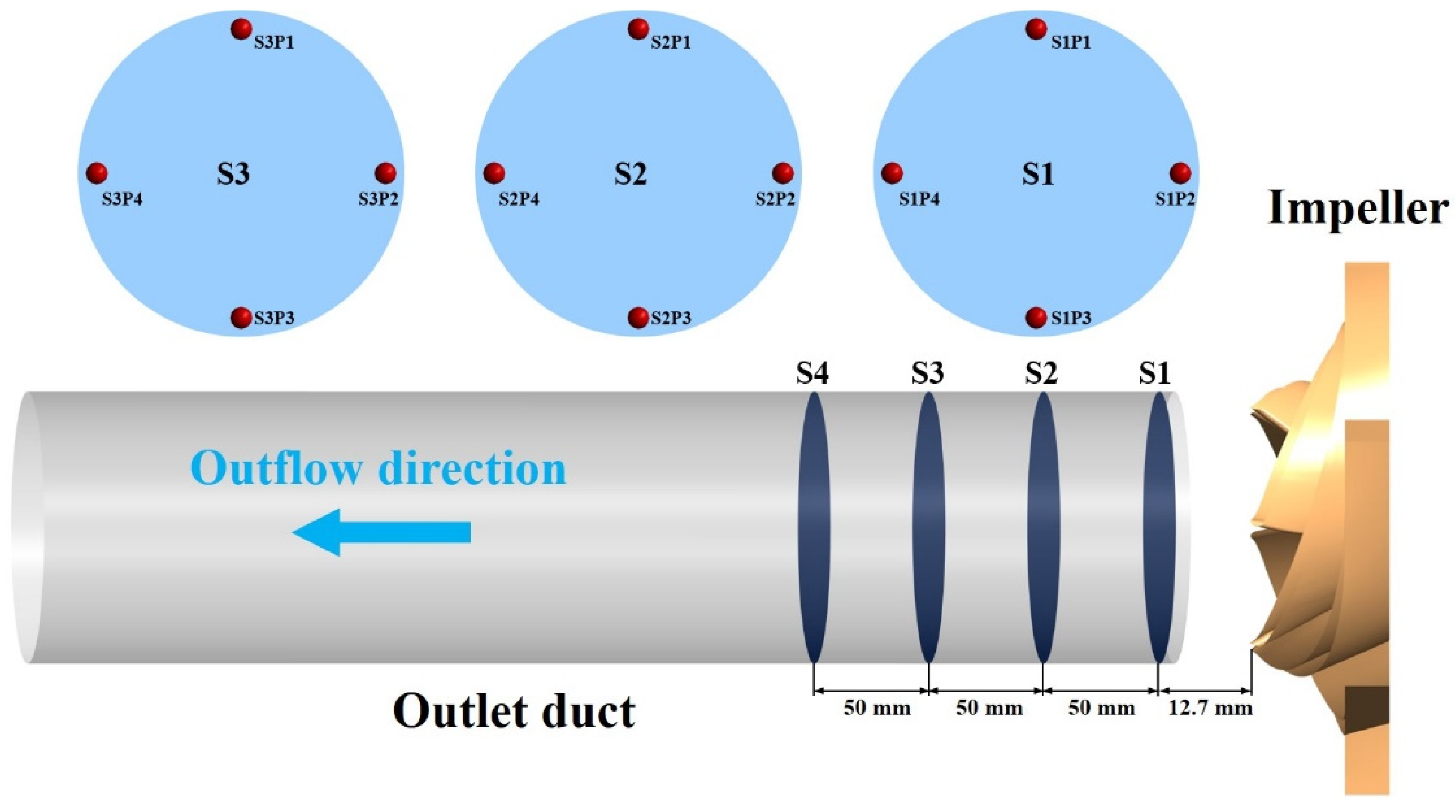
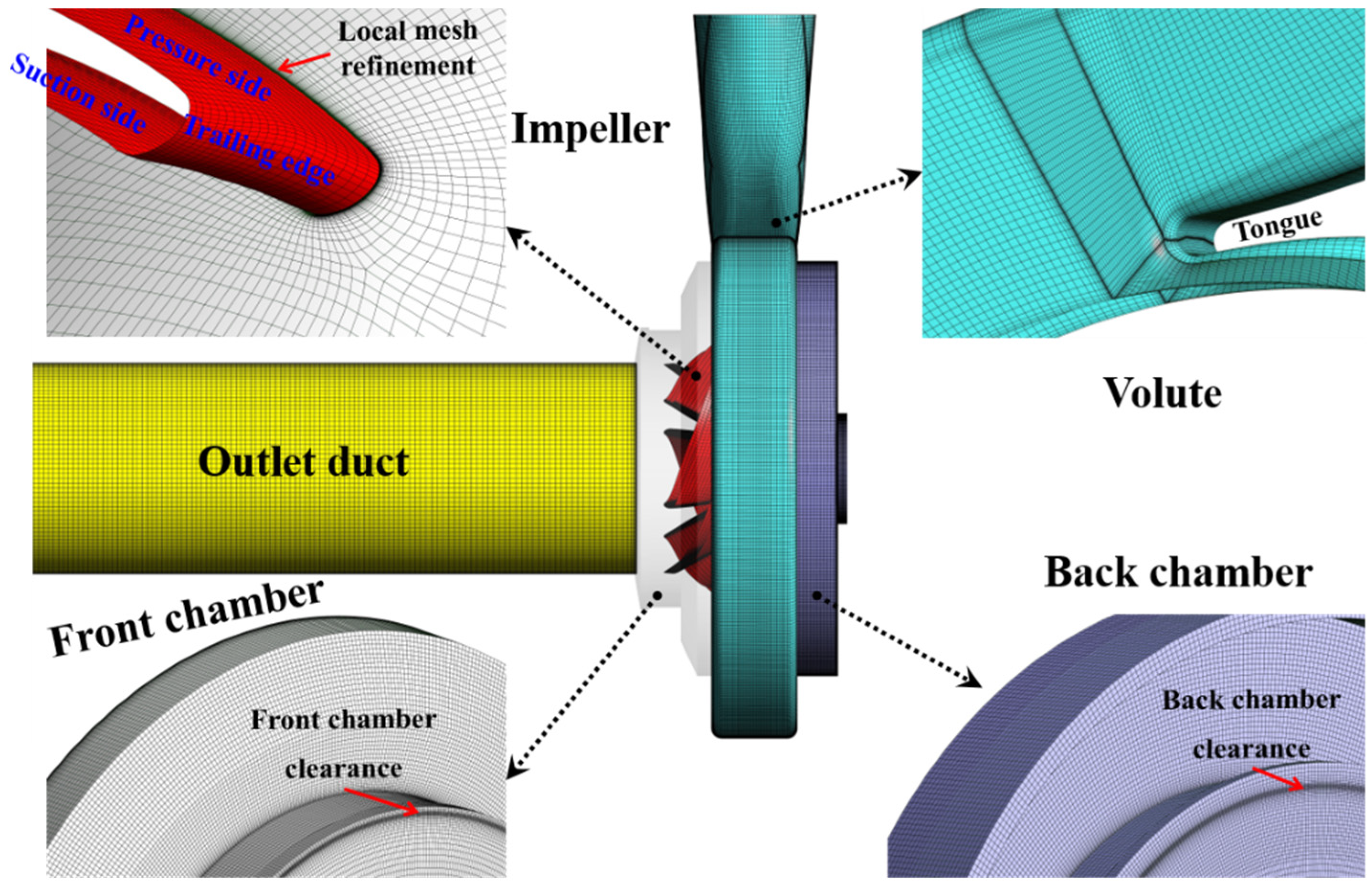
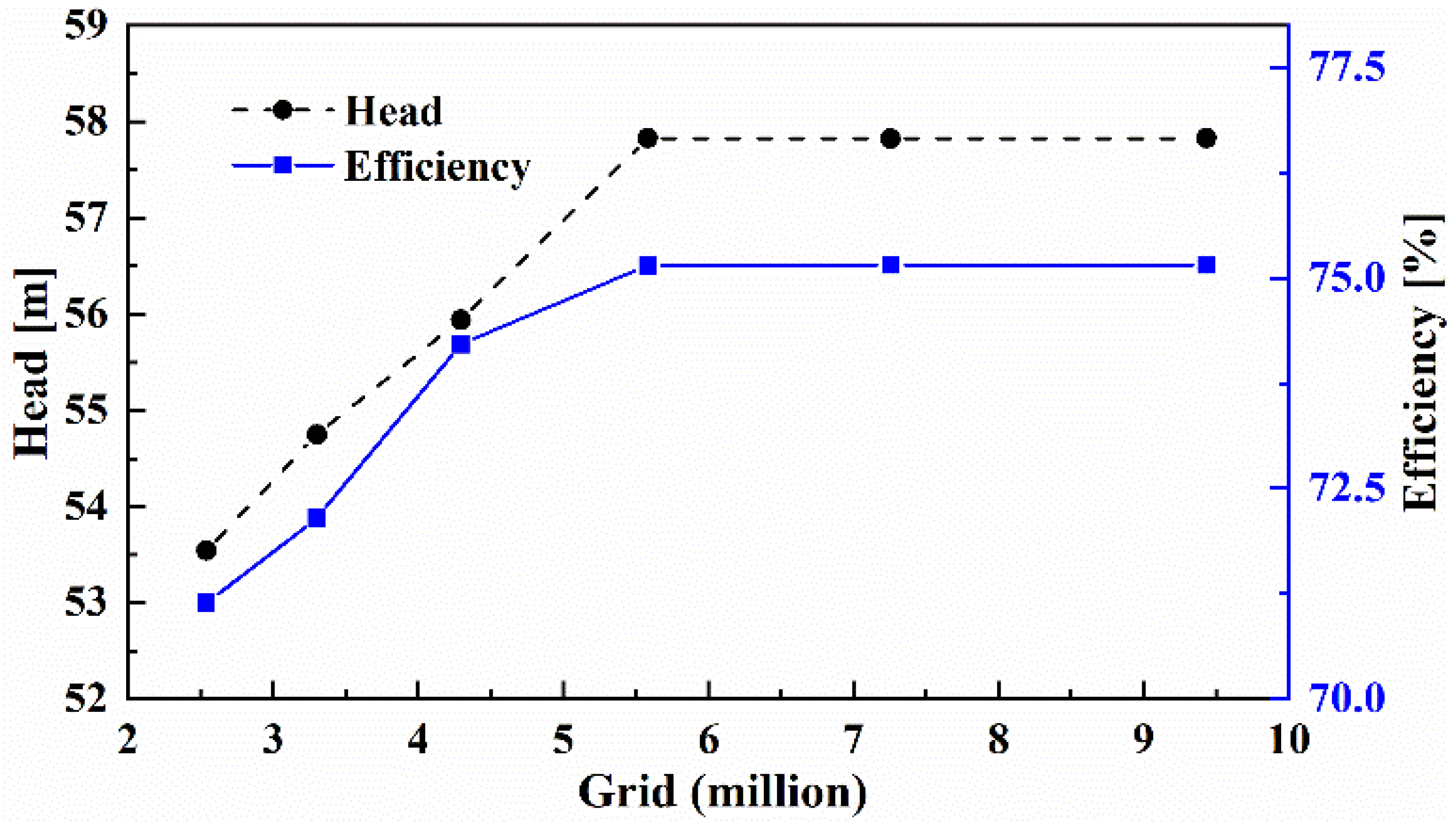
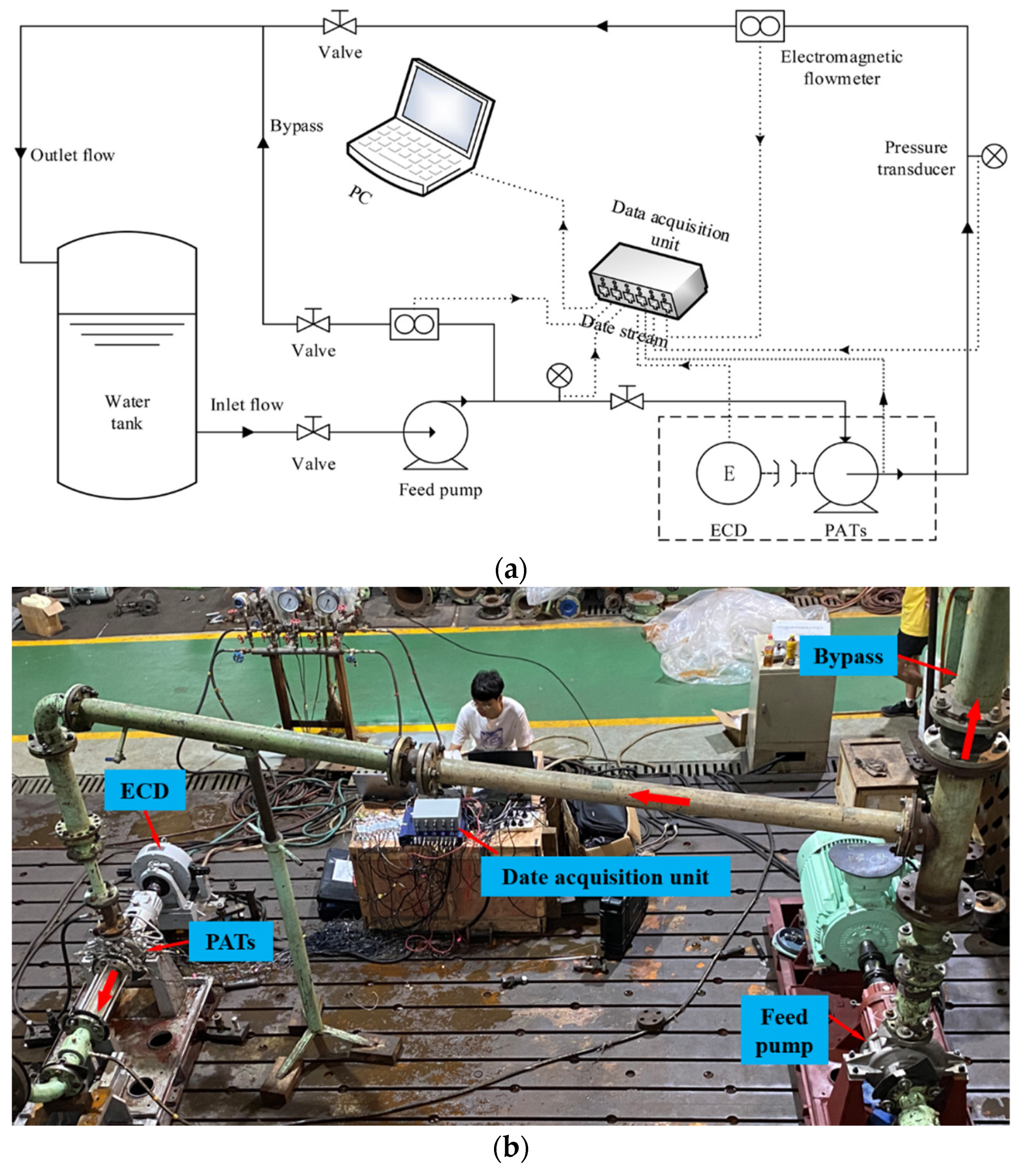
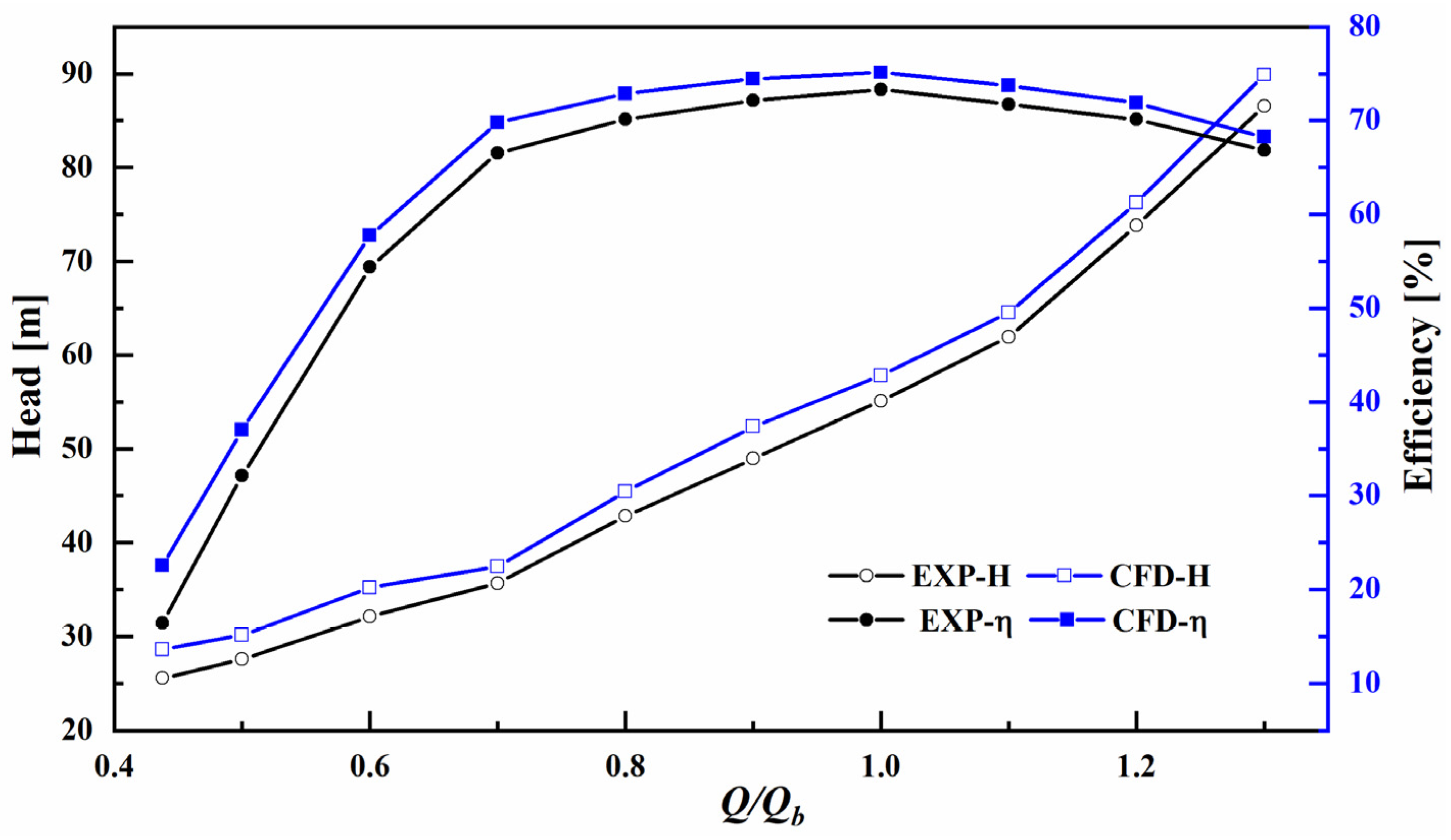
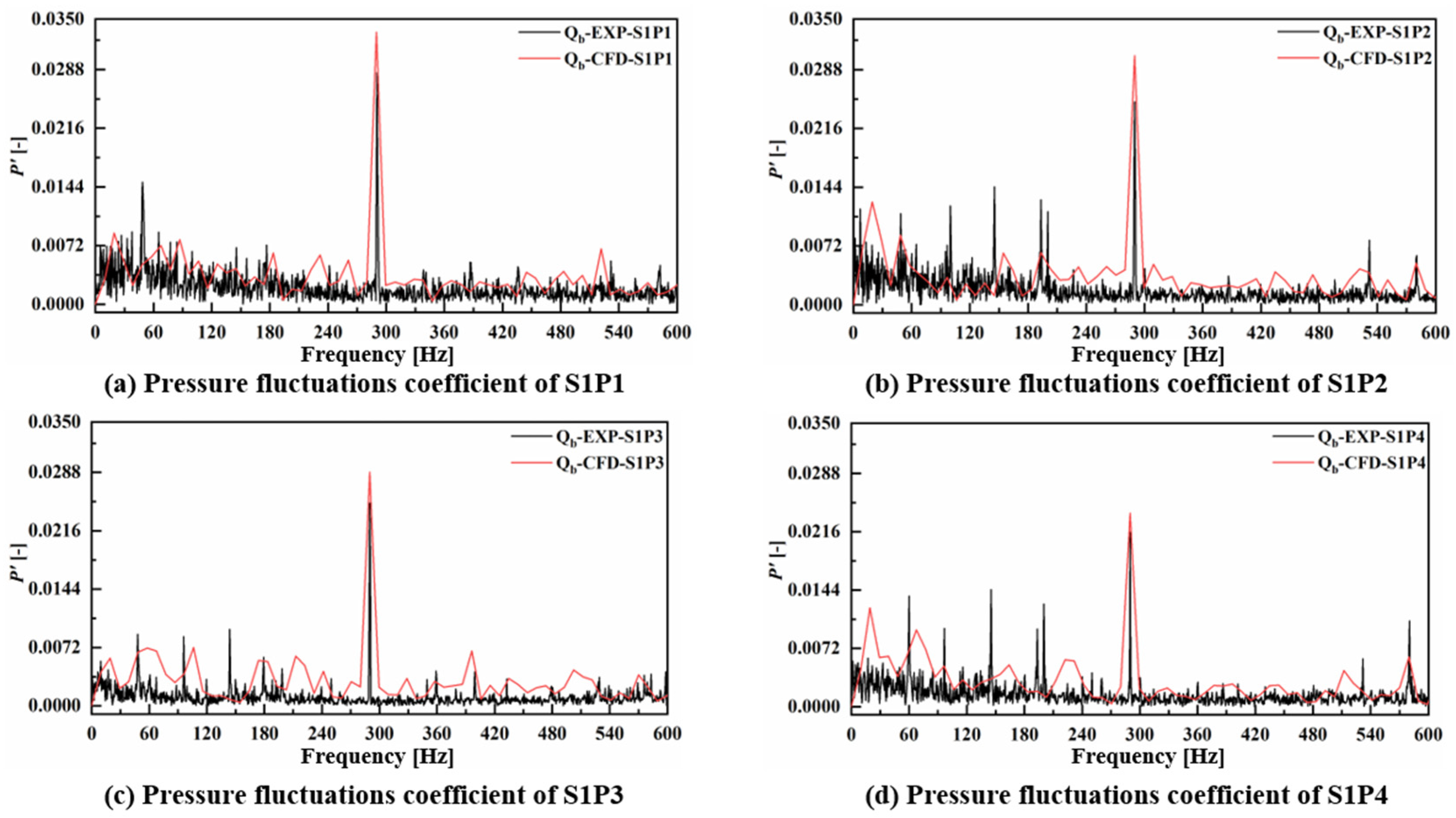
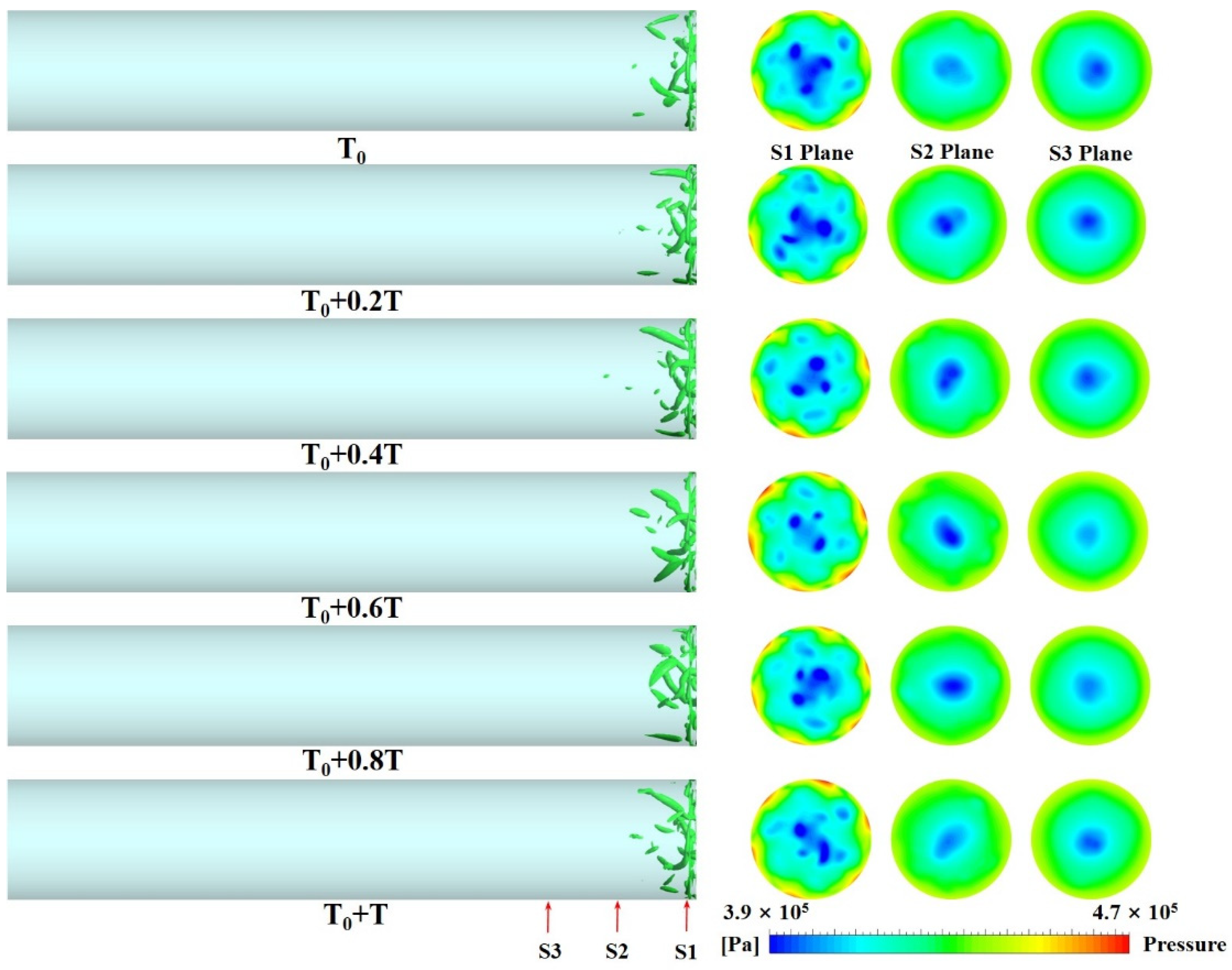
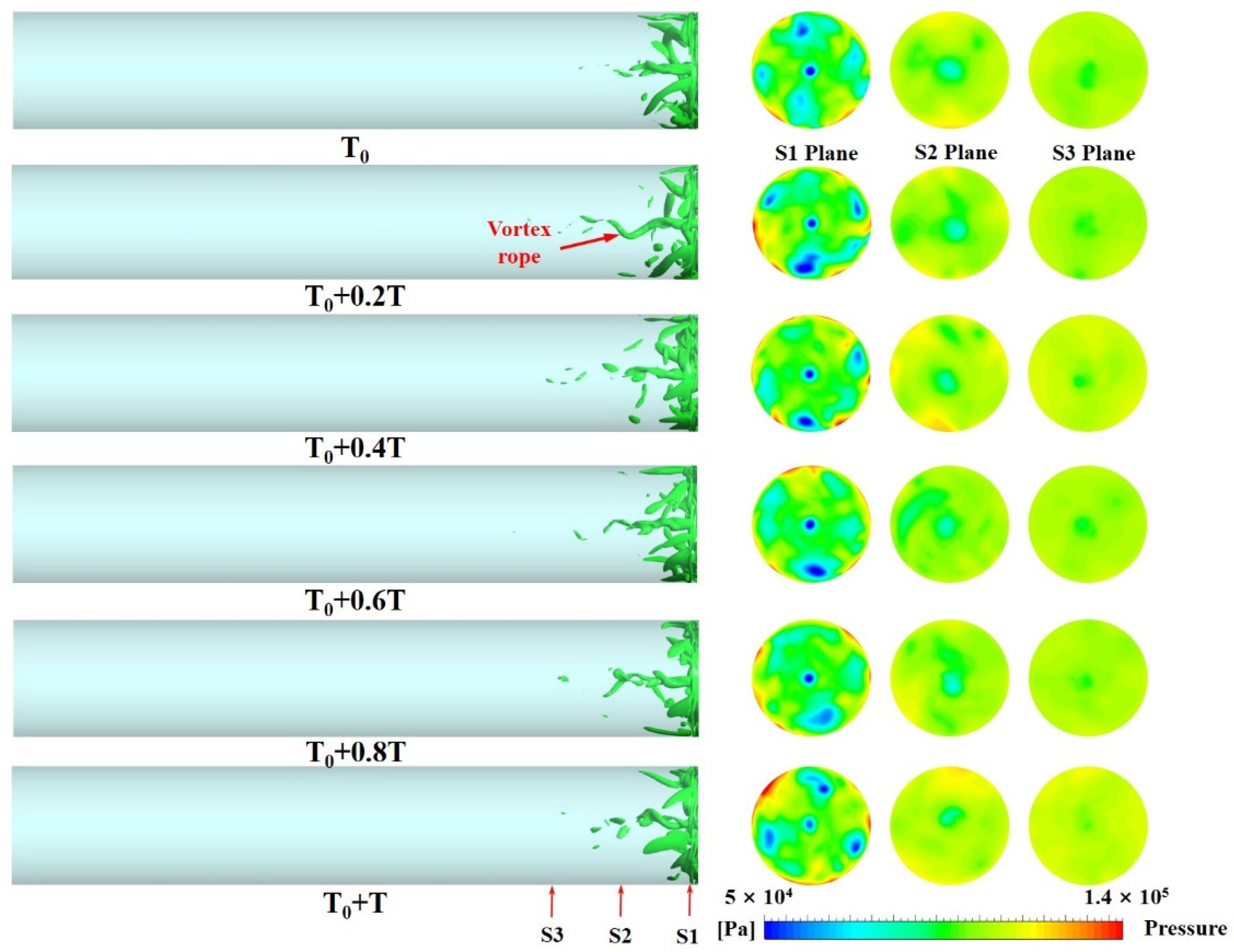
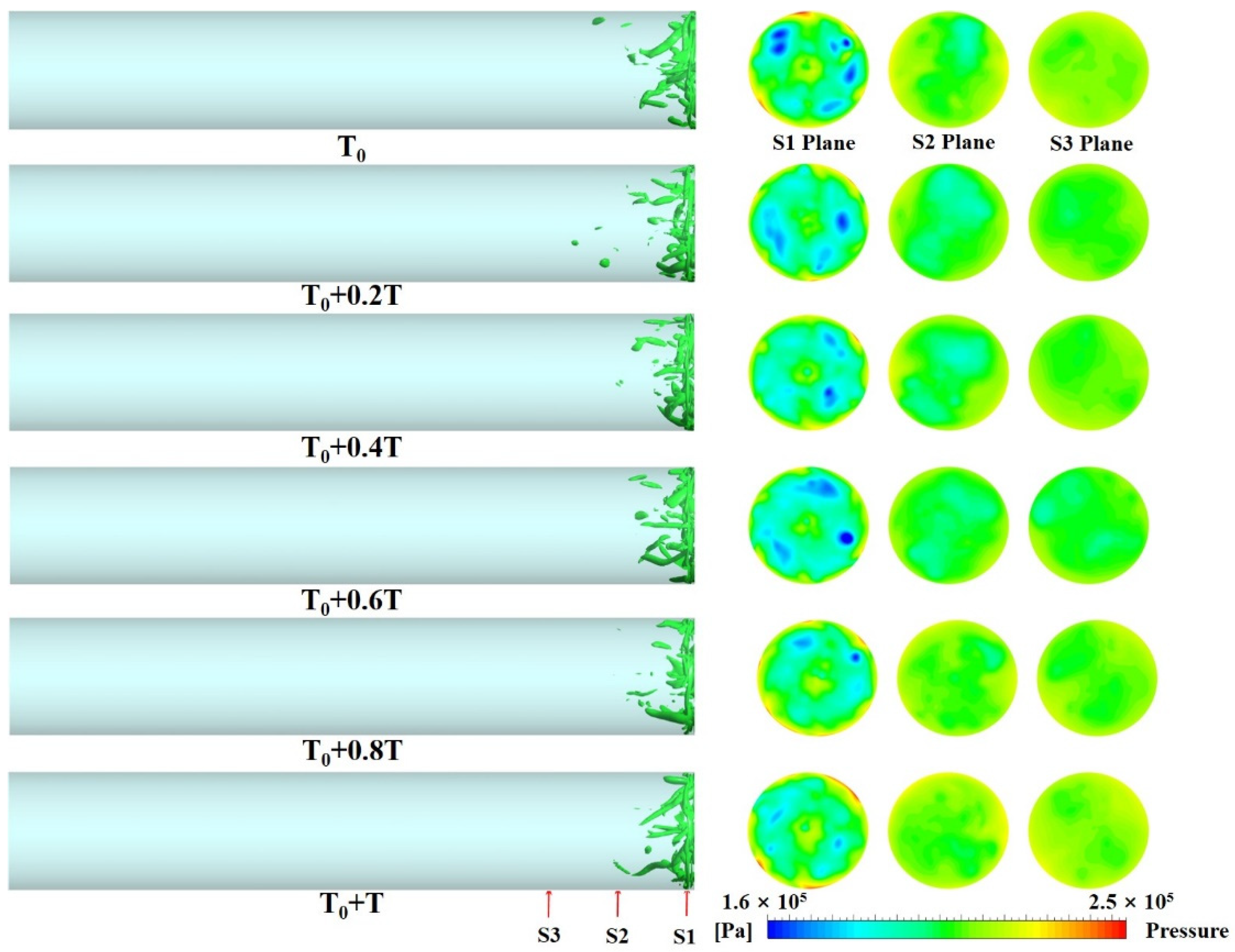
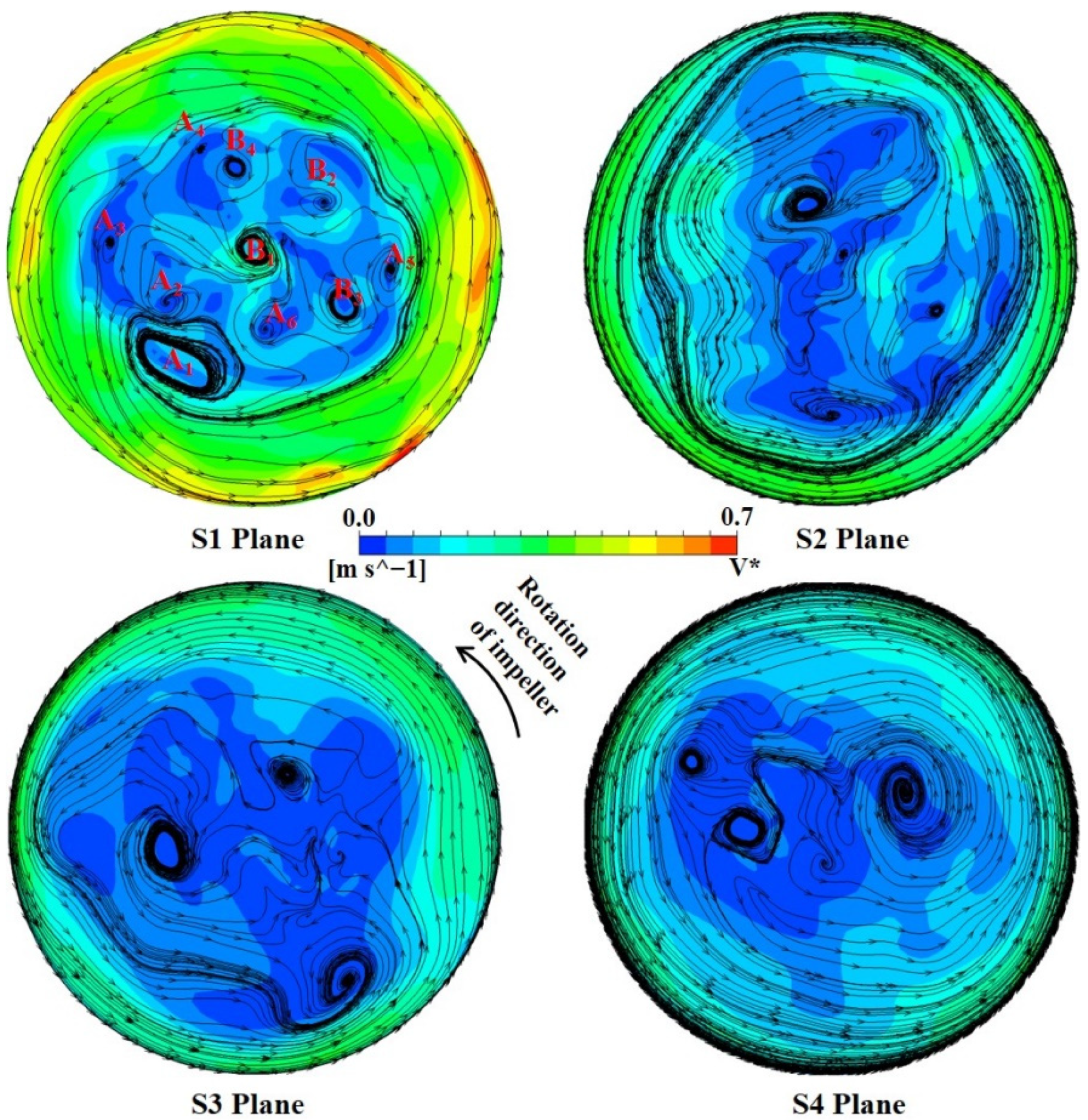
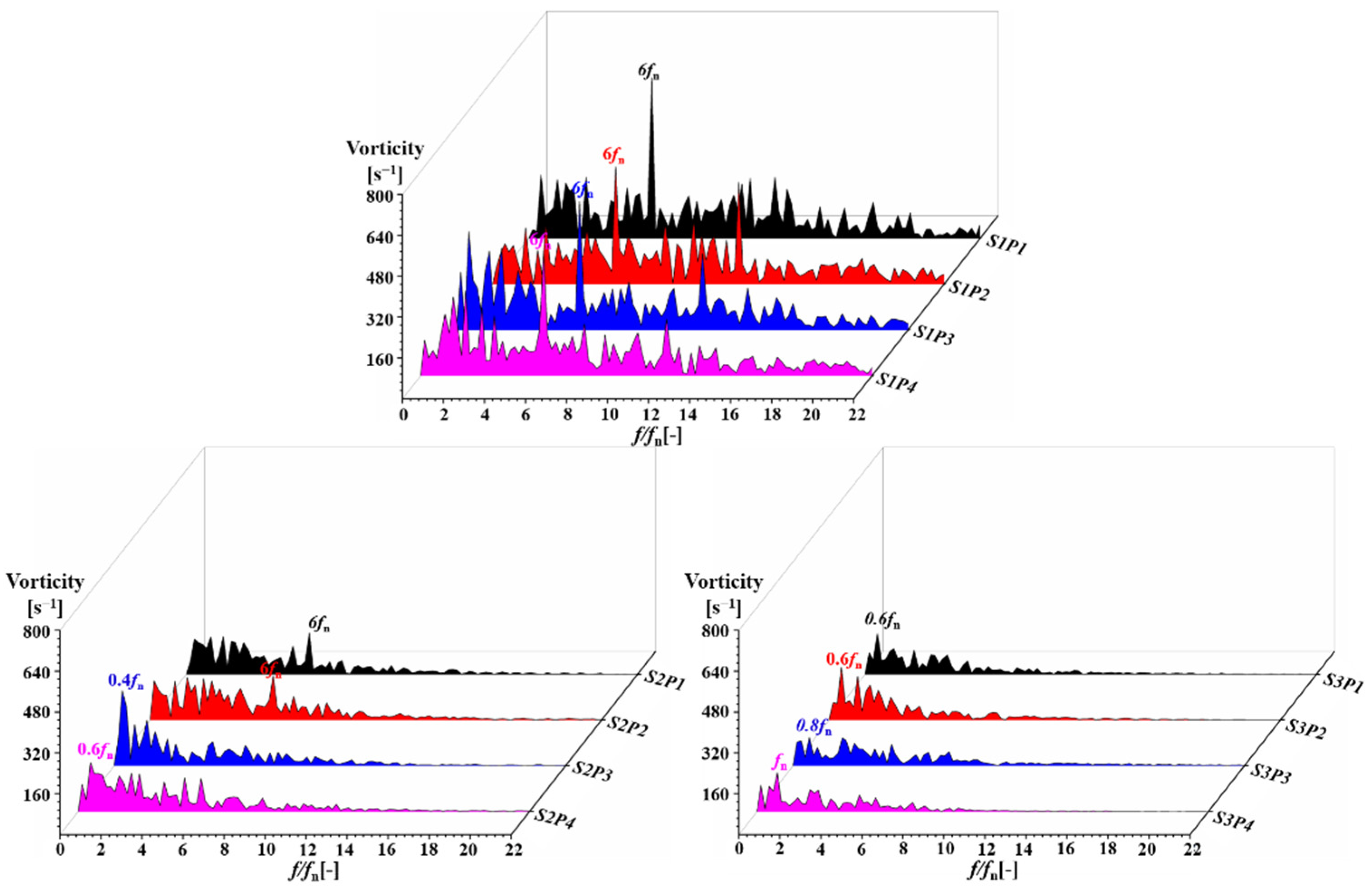

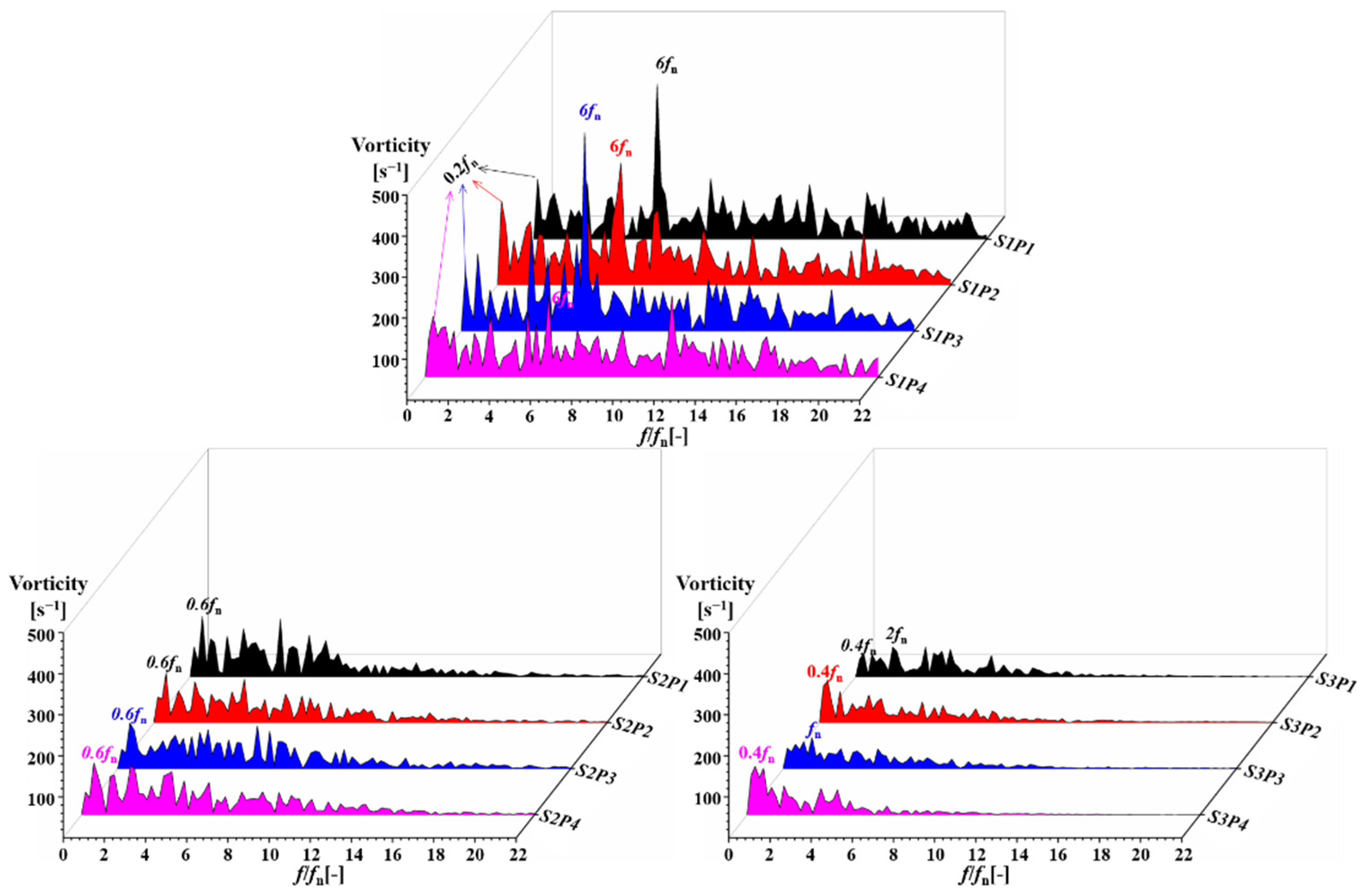
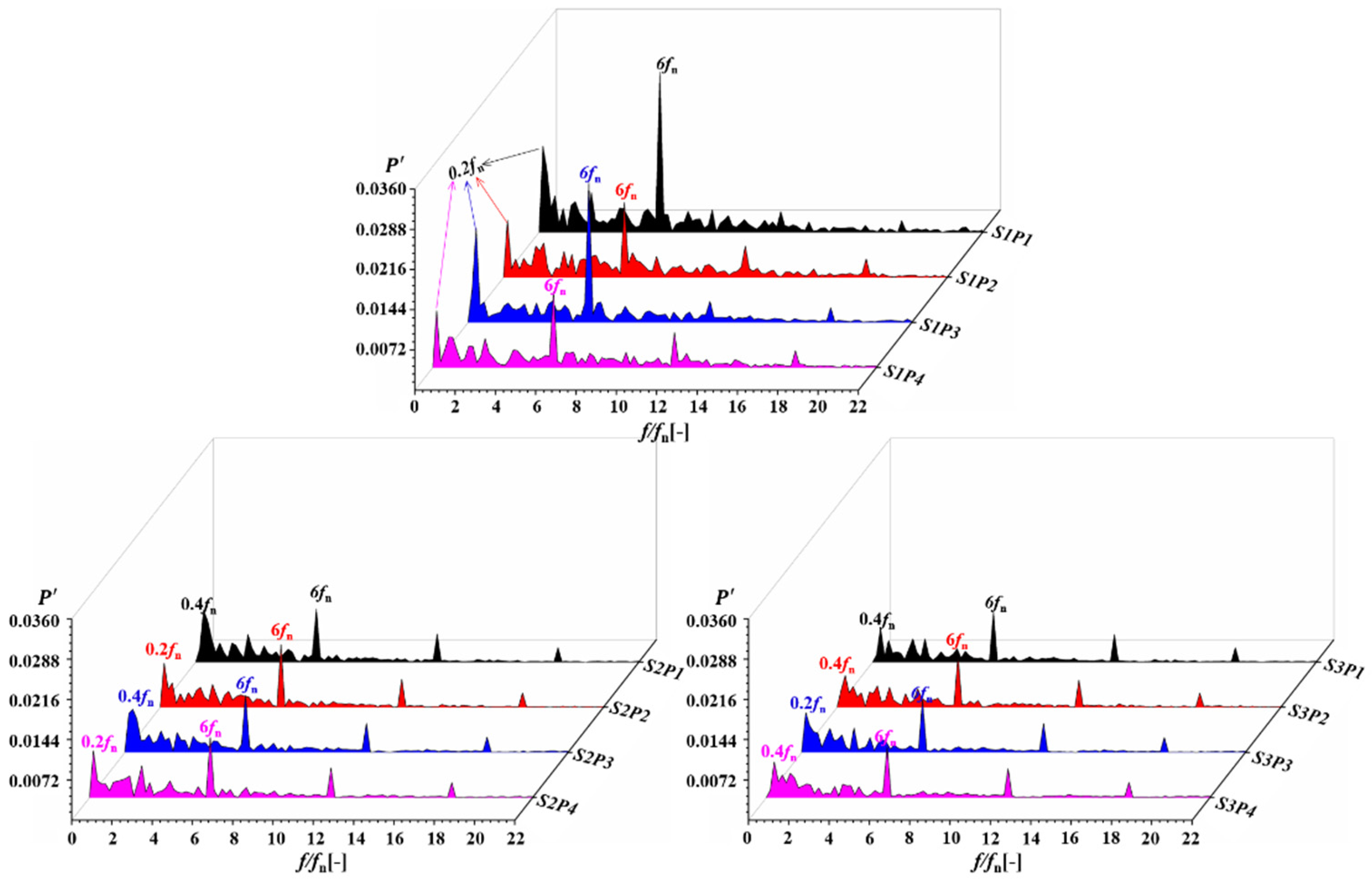
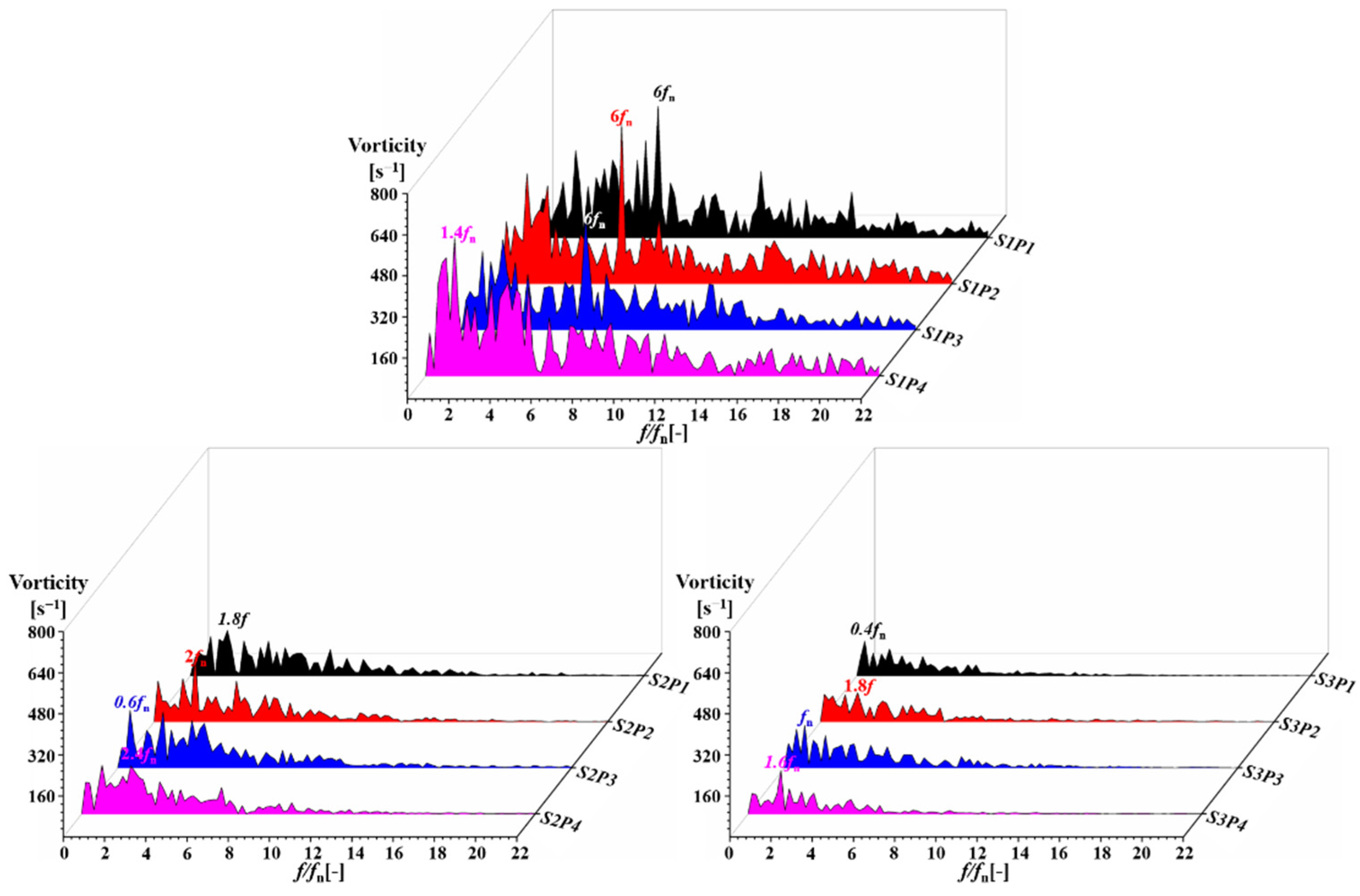
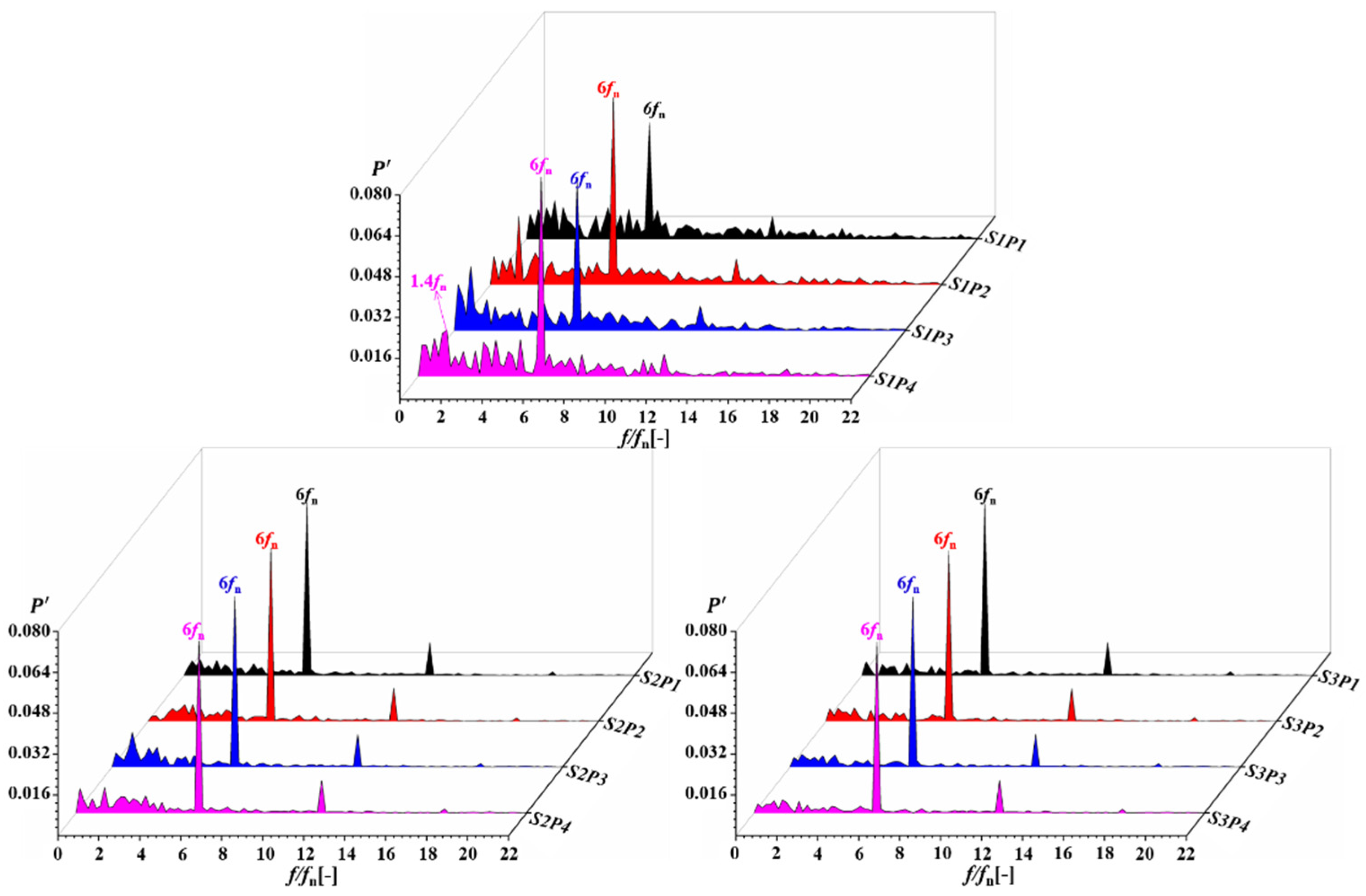
| Parameter | Notation | Value | Parameter | Notation | Value |
|---|---|---|---|---|---|
| Impeller inlet diameter (mm) | D1 | 169 | Blade inlet angle (°) | β2 | 25 |
| Impeller outlet diameter (mm) | D2 | 86 | Blade outlet angle (°) | β1 | 30 |
| Impeller inlet width (mm) | b1 | 14 | Volute base circle diameter (mm) | D3 | 172 |
| Impeller outlet width (mm) | b2 | 20 | Blade number | Z | 6 |
| H (m) | 1.32 | 1.31 | 0.986 | 57.83 | 0.0032% | 0.0104% | 1.30% | 57.82 | 0.0024% | 0.0079% | 0.99% |
| η (%) | 1.32 | 1.31 | 4.943 | 75.16 | 0.0014% | 0.0005% | 0.06% | 75.16 | 0.0052% | 0.0019% | 0.23% |
| Domain | Node (Million) | Wall Average y+ | Worst Quality |
|---|---|---|---|
| Inlet duct | 0.3415 | 3.24 | 0.88 |
| Volute | 2.6914 | 6.37 | 0.52 |
| Impeller | 2.7624 | 6.24 | 0.43 |
| Front chamber | 0.4764 | 5.54 | 0.74 |
| Back chamber | 0.6213 | 4.84 | 0.72 |
| Outlet duct | 0.3649 | 3.76 | 0.87 |
Publisher’s Note: MDPI stays neutral with regard to jurisdictional claims in published maps and institutional affiliations. |
© 2022 by the authors. Licensee MDPI, Basel, Switzerland. This article is an open access article distributed under the terms and conditions of the Creative Commons Attribution (CC BY) license (https://creativecommons.org/licenses/by/4.0/).
Share and Cite
Lin, T.; Li, J.; Xie, B.; Zhang, J.; Zhu, Z.; Yang, H.; Wen, X. Vortex-Pressure Fluctuation Interaction in the Outlet Duct of Centrifugal Pump as Turbines (PATs). Sustainability 2022, 14, 15250. https://doi.org/10.3390/su142215250
Lin T, Li J, Xie B, Zhang J, Zhu Z, Yang H, Wen X. Vortex-Pressure Fluctuation Interaction in the Outlet Duct of Centrifugal Pump as Turbines (PATs). Sustainability. 2022; 14(22):15250. https://doi.org/10.3390/su142215250
Chicago/Turabian StyleLin, Tong, Jian Li, Baofei Xie, Jianrong Zhang, Zuchao Zhu, Hui Yang, and Xiaoming Wen. 2022. "Vortex-Pressure Fluctuation Interaction in the Outlet Duct of Centrifugal Pump as Turbines (PATs)" Sustainability 14, no. 22: 15250. https://doi.org/10.3390/su142215250
APA StyleLin, T., Li, J., Xie, B., Zhang, J., Zhu, Z., Yang, H., & Wen, X. (2022). Vortex-Pressure Fluctuation Interaction in the Outlet Duct of Centrifugal Pump as Turbines (PATs). Sustainability, 14(22), 15250. https://doi.org/10.3390/su142215250





